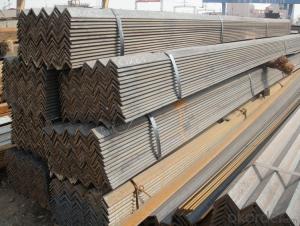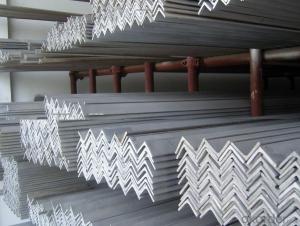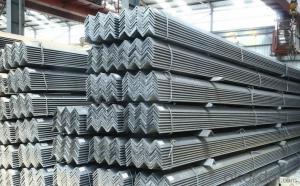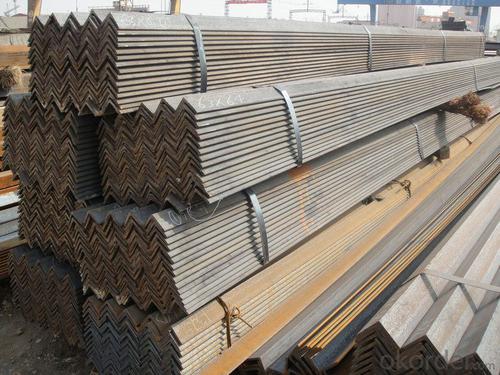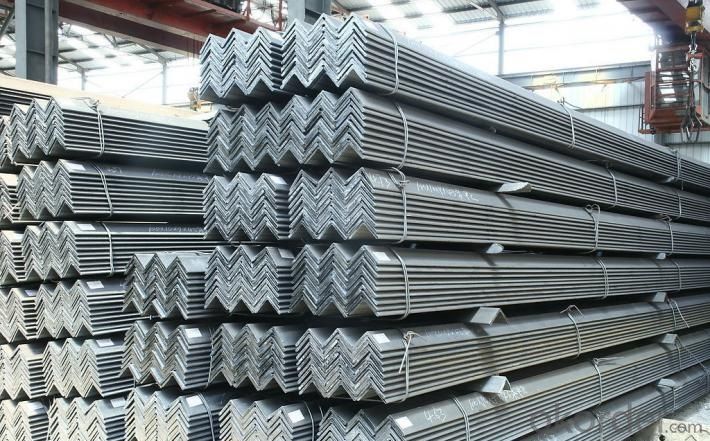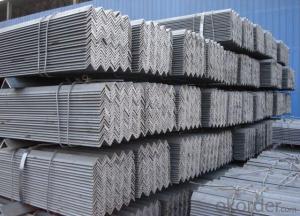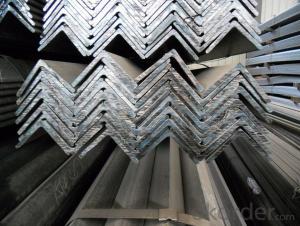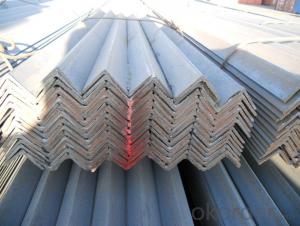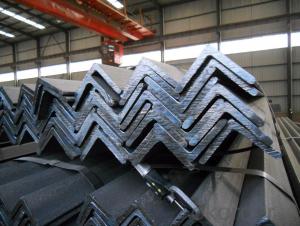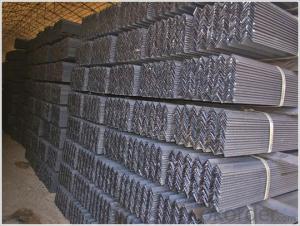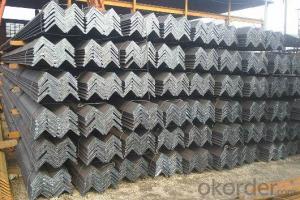Hot Rolled Steel Angle Bar with High Quality 60*60mm
- Loading Port:
- Tianjin
- Payment Terms:
- TT OR LC
- Min Order Qty:
- 25 m.t
- Supply Capability:
- 10000 m.t/month
OKorder Service Pledge
OKorder Financial Service
You Might Also Like
Product Description
Specifications of Equal Angle Steel
1.Standards:GB
2.Length:6m, 12m
3.Material:GBQ235 or Equivalent
4. Size:
Size (mm) | Mass (mm) | Size (mm) | Mass (mm) |
| 60*60*4 | 3.643 | 63*63*5 | 4.822 |
| 60*60*5 | 4.514 | 63*63*6 | 5.721 |
Usage & Applications of Equal Anlge Steel
Trusses;
Transmission towers;
Telecommunication towers;
Bracing for general structures;
Stiffeners in structural use.
Packaging & Delivery of Equal Angle Steel
1. Transportation: the goods are delivered by truck from mill to loading port, the maximum quantity can be loaded is around 40MTs by each truck. If the order quantity cannot reach the full truck loaded, the transportation cost per ton will be little higher than full load.
2. With bundles and load in 20 feet/40 feet container, or by bulk cargo, also we could do as customer's request.
3. Marks:
Color mark: There will be color marking on both end of the bundle for the cargo delivered by bulk vessel. That makes it easily to distinguish at the destination port.
Tag mark: There will be tag mark tied up on the bundles. The information usually including supplier logo and name, product name, made in China, shipping marks and other information request by the customer.
If loading by container the marking is not needed, but we will prepare it as customer request.
FAQ:
Q1: Why buy Materials & Equipment from OKorder.com?
A1: All products offered byOKorder.com are carefully selected from China's most reliable manufacturing enterprises. Through its ISO certifications, OKorder.com adheres to the highest standards and a commitment to supply chain safety and customer satisfaction.
Q2: How do we guarantee the quality of our products?
A2: We have established an advanced quality management system which conducts strict quality tests at every step, from raw materials to the final product. At the same time, we provide extensive follow-up service assurances as required.
Q3: How soon can we receive the product after purchase?
A3: Within three days of placing an order, we will arrange production. The shipping date is dependent upon the quatity, how many sizes you want and the plan of production, but is typically 30 to 45 days from the beginning of production.
Images:
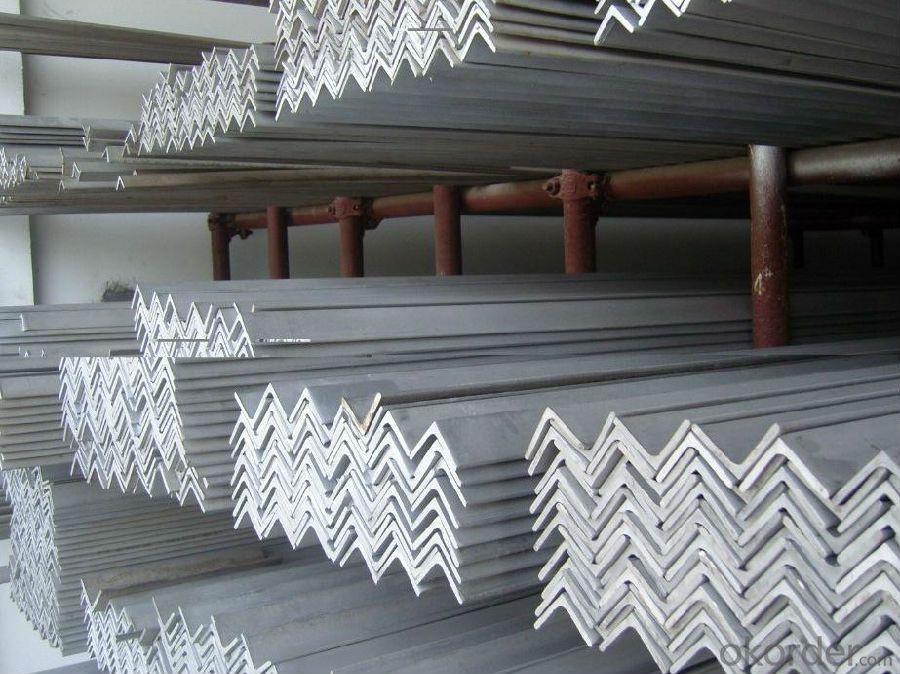
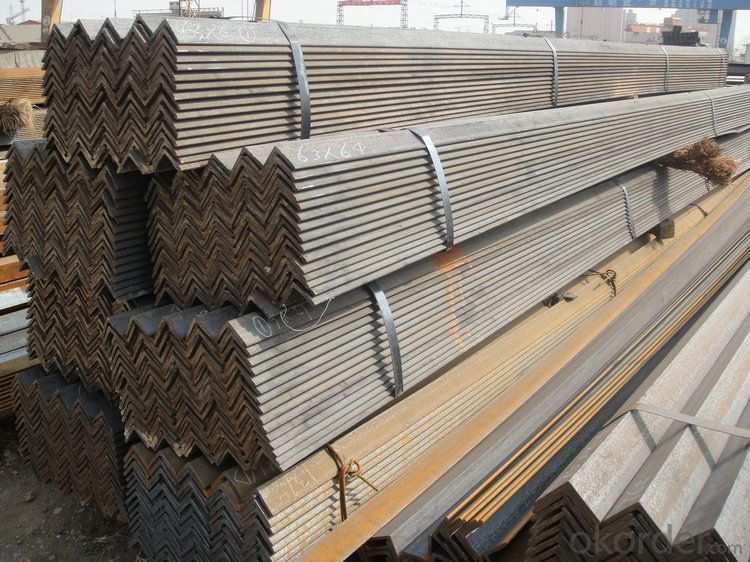
*If you would like to get our price, please inform us the size, standard/material and quantity. Thank you very much for your attention.
- Q: What are the different types of steel angles used in transmission line towers?
- There are typically three types of steel angles used in transmission line towers: equal leg angles, unequal leg angles, and back-to-back angles. Equal leg angles have equal dimensions on both sides, while unequal leg angles have different dimensions on each side. Back-to-back angles consist of two equal leg angles joined back-to-back to form a single unit. These different types of angles allow for flexibility and strength in designing and constructing transmission line towers.
- Q: Are steel angles suitable for manufacturing shelving units?
- Yes, steel angles are highly suitable for manufacturing shelving units due to their strength, durability, and versatility. Steel angles provide excellent support and stability, making them ideal for supporting heavy loads and maximizing storage space. Additionally, their rigid structure allows for easy customization and installation, making them a popular choice in the manufacturing of shelving units.
- Q: How do steel angles perform in terms of acoustic insulation?
- Steel angles, being primarily used for structural purposes, do not offer significant acoustic insulation. They are not designed to dampen or block sound transmission. Therefore, if acoustic insulation is a priority, alternative materials or specific soundproofing solutions should be considered.
- Q: What is the difference between hot-rolled and cold-formed steel angles?
- Hot-rolled steel angles and cold-formed steel angles are both used in various construction and industrial applications, but they differ in their manufacturing processes and resulting characteristics. Hot-rolled steel angles are produced by heating a steel billet or slab above its recrystallization temperature and then passing it through a series of rollers to achieve the desired shape. This process allows for the formation of bends, curves, and other complex angles. Hot rolling also results in a rougher surface finish and a slightly rounded edge, which may be favorable in certain applications. Additionally, hot-rolled steel angles tend to have a wider range of sizes and thicknesses available. On the other hand, cold-formed steel angles are made by bending a flat strip of steel at room temperature using a series of dies and rolls. This process does not involve heating the steel, which maintains its existing physical properties. As a result, cold-formed steel angles have a smoother surface finish and sharper, more defined edges compared to hot-rolled angles. The cold-forming process also allows for tighter tolerances and more precise dimensions. In terms of mechanical properties, hot-rolled steel angles generally have higher tensile strength and yield strength compared to cold-formed angles. This is due to the heat treatment involved in hot rolling, which refines the grain structure and enhances the overall strength of the steel. Cold-formed steel angles, while usually less strong, are often preferred in applications where weight reduction is a priority, as they are generally lighter than their hot-rolled counterparts. In summary, the main differences between hot-rolled and cold-formed steel angles lie in their manufacturing processes, resulting surface finish, dimensional precision, and mechanical properties. The choice between the two depends on the specific requirements and constraints of the project at hand.
- Q: How do you calculate the bending capacity of a steel angle?
- In order to determine the bending capacity of a steel angle, several factors must be considered. The initial step involves calculating the moment of inertia (I) of the angle section, which measures its resistance to bending. The moment of inertia relies on the angle's shape and dimensions, and can be found in the manufacturer's specifications or through calculations. Once the moment of inertia has been obtained, the section modulus (Z) can be calculated as another indicator of the section's ability to resist bending. The section modulus is found by dividing the moment of inertia by the distance from the centroid of the section to the extreme fiber. Subsequently, it is necessary to establish the maximum allowable bending stress (σ) for the steel angle. This value is typically provided by the manufacturer or can be determined based on the desired safety factor and the type of steel being used. Lastly, the bending capacity (M) of the steel angle can be calculated by utilizing the formula M = σ * Z. This calculation provides the maximum moment that the angle can endure without experiencing excessive bending stress. It is important to note that these calculations assume the angle's behavior is elastic and do not account for additional factors such as local buckling, residual stresses, or combined loading. Therefore, it is advisable to consult relevant design codes or guidelines for a more comprehensive analysis to ensure the safety and reliability of the steel angle in a specific application.
- Q: How do steel angles compare to other structural shapes like beams and channels?
- Steel angles, beams, and channels are all structural shapes commonly used in construction and engineering projects. While each shape has its own unique characteristics and advantages, steel angles offer specific benefits that make them a popular choice. One key advantage of steel angles is their versatility. They can be used in a wide range of applications, including supporting heavy loads, bracing structures, and providing framework for various structures. Due to their L-shaped design, steel angles can easily be welded or bolted together to create larger structures or frameworks. Compared to steel beams, angles are typically more cost-effective. They require less material to manufacture, making them a more economical choice for projects with budget constraints. Additionally, steel angles are often lighter in weight compared to beams, which can be beneficial when considering transportation and installation costs. Steel channels, on the other hand, offer similar benefits to steel angles but have a different shape. Channels have a U-shaped design, which allows for increased stability and support. They are commonly used for applications where additional strength is required, such as in the construction of bridges, buildings, and machinery. While steel angles may not provide the same level of strength and load-bearing capacity as steel beams or channels, they are still a reliable choice for many structural applications. Their versatility, cost-effectiveness, and ease of installation make them a preferred option for a wide range of construction and engineering projects.
- Q: What are the typical fabrication processes involved in manufacturing steel angles?
- The typical fabrication processes involved in manufacturing steel angles include cutting, forming, welding, and surface treatment.
- Q: Are steel angles suitable for agricultural applications?
- Indeed, steel angles prove to be apt for agricultural applications. These multifunctional and long-lasting steel angles are well-suited for a range of agricultural needs. They can be employed to fashion robust frameworks for greenhouses, barns, and storage structures. By delivering exceptional structural reinforcement and enduring the weight of hefty burdens, steel angles are well-matched for erecting sturdy barriers, gates, and enclosures for livestock. Moreover, as steel angles are resistant to corrosion, they prove indispensable in agricultural settings that frequently encounter dampness and chemicals. The reliability of steel angles, owing to their adaptability and durability, renders them an optimal choice for agricultural purposes.
- Q: How do steel angles perform in terms of thermal expansion and contraction?
- Steel angles have a low coefficient of thermal expansion, which means they are relatively resistant to expansion and contraction due to temperature changes. This makes them a reliable choice for structures that require stability and minimal distortion under varying thermal conditions.
- Q: How are steel angles protected against abrasion?
- Steel angles are commonly used in construction and industrial applications, where they are subject to various forms of abrasion. To protect steel angles against abrasion, several methods are employed. One common method is the application of protective coatings. These coatings can be in the form of paints, epoxy coatings, or other specialized coatings designed for abrasion resistance. The coatings act as a barrier between the steel surface and the abrasive elements, preventing direct contact and reducing the wear and tear caused by friction. Another method is the use of rubber or plastic linings. These linings are typically applied to the surfaces of the steel angles that are most prone to abrasion. The rubber or plastic material absorbs the impact of abrasive forces, cushioning the steel and reducing the wear rate. Additionally, these linings provide an extra layer of protection against corrosion and chemical attacks. In some cases, steel angles may undergo a process called hardening or heat treatment. This involves subjecting the steel to high temperatures and then rapidly cooling it. This process alters the microstructure of the steel, making it harder and more resistant to abrasion. Heat-treated steel angles are commonly used in high-wear environments such as mining and material handling industries. Furthermore, engineers may opt to design steel angles with specific profiles or shapes that offer better resistance to abrasion. These profiles can include rounded edges, chamfers, or other features that minimize direct contact with abrasive materials. Overall, the protection against abrasion for steel angles involves a combination of protective coatings, linings, heat treatment, and thoughtful design. By implementing these measures, the lifespan and performance of steel angles can be significantly prolonged, reducing maintenance costs and ensuring their durability in abrasive environments.
Send your message to us
Hot Rolled Steel Angle Bar with High Quality 60*60mm
- Loading Port:
- Tianjin
- Payment Terms:
- TT OR LC
- Min Order Qty:
- 25 m.t
- Supply Capability:
- 10000 m.t/month
OKorder Service Pledge
OKorder Financial Service
Similar products
Hot products
Hot Searches
Related keywords
